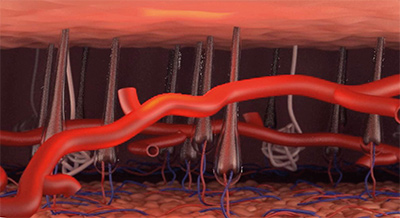What is CLaCS?
This revolutionary treatment combines laser and chemical reactions to treat tiny superficial veins in the skin, otherwise known as Thread veins, Reticular veins, Telangiectasia or Spider veins.
How does it work?

Utilising both techniques in the same treatment enhancers their effectiveness compared to either laser application or chemical (sclerotherapy) injection alone.
The laser heat is designed to penetrate the skin to the depth where the vein is, and to be absorbed by the inner wall of the blood vessels causing irreversible thermal (heat) injury, termed ‘Photothermolysis’. The effect of the mild sclerosant chemical which is injected during the treatment with a tiny needle into the same vein is to enhance the damage caused by laser and to close the vein more effectively and permanently.
The effectiveness of the CLaCS procedure is further improved by using the ‘VeinViewer’. This device uses infrared technology and a special computer software to detect the veins under the skin (up to 1.5 mmm), even those that cannot be seen by the naked eye. The image of the vein is then projected and displayed on the skin exactly over the vein to allow the surgeon to place a very small needle into the vein in a manner which would not be otherwise possible.
Is it painful?
As anyone who has had laser to their skin is aware, these treatments can be quite painful due to the heat generated by the laser machine. During the CLaCS procedure a special applicator is used to maintain a constant stream of very cold air onto the skin where the treatment is taking place. This cold air causes numbness acting like an anaesthetic, thereby minimising any discomfort during the procedure. For those with especially sensitive skin an anaesthetic cream can be applied to the area designated for treatment a few minutes before the procedure.
How long until effects of treatment seen?
The veins in the treated area begin to disappear immediately after the treatment. However, initially the blood flow within these vessels becomes stagnant as a result of the treatment. In the 1 -2 weeks after the procedure, these stagnant spider veins may turn a brown colour before the body’s immune system start to clear them. This stagnant blood (micro thrombosis) poses no risks to the circulation and is not to be confused with Deep Vein Thrombosis in which large clots are formed in the main veins in the legs.
By 2 to 3 weeks a noticeable improvement is noted by most patients, and by 3 months almost no veins are visible. Occasionally (20-30% of cases), some spider veins persist. This is not due to the ineffectiveness of the laser but more likely related to the different depths under the skin where these lesions can be or how effectively the feeder veins have been treated. As each treatment is designed to treat the veins at a particular depth or the totality of the feeder veins, further treatments may be required to permanently remove all the veins in a particular skin area.
Where does the treatment take place and how many sessions needed?
The treatment is ambulatory, meaning that patients walk into the treatment room and walk out afterwards Typically, an area the size of the palm of the hand (10x10cm) requires 2-3 sessions each 3 weeks apart. The treatment can be varied in length depending on the size of the area treated and the number of laser ‘shots’ required, the average treatment time being around 45 minutes. In some patients bandaging or compression stockings are required for up to 2 weeks, but no time off work is needed for recovery.
Can the veins come back?
Recurrence of the veins is uncommon and is reduced in frequency when the feeding veins in the deeper layers of the skin are identified (with the VeinViewer) and treated in conjunction with the spider veins. Whilst uncommon, permanent discolouration (1%) at the site of the treatment has been reported as well as rarer problems such as skin burn (0.2%) and matting (0.06%). This can be minimised by spreading the treatment of the more concentrated lesions into several sessions separated by time intervals.





